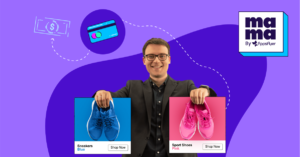
How to set up your programmatic app campaigns for success
Welcome to the seventeenth edition of MAMA Boards, an AppsFlyer video project featuring leading mobile marketing experts on camera.
For today’s mini whiteboard master class, we have Mark Avidan, Media Department Lead at Playtika, one of the leading gaming companies with multiple games in the top grossing charts in the US and worldwide.
Programmatic app campaigns are a growing opportunity for boosting performance, but they still remain a mystery to many marketers. Follow Mark as he covers the basis of this important new channel and later offers actionable tips for making your campaign risks worth the rewards.
Real experts, real growth. That’s our motto.
Enjoy!
Transcription
Hi, welcome to another edition of MAMA Boards by AppsFlyer. My name is Mark, and I’m the [Media Department Lead] at Playtika, one of the world’s biggest mobile gaming developers. Today, we’re going to discuss “How to Set Up Your Programmatic App Campaigns for Success” – basically discussing DSPs, SSPs, and Mobile Ad Exchanges.
So, before we start, a brief explanation about some of the terms I just used. What are DSPs, SSPs, and Ad Exchanges? A DSP is the software that we use to buy media using an algorithm for maximizing our bidding effort. A DSP is basically designed to do the optimal bidding per single impression and give us the maximum best result.
An SSP, on the contrary, is a tool that provides the publisher, app, or website with the ability to monetize their ads, not just through a couple of vendors, but by merging all the vendors into one exchange. That directly benefits them and gives their inventory to ad networks, exchanges, DSPs, and everybody that can connect to them.
Okay, let’s get started.
Why use this channel [programmatic] to begin with?
The current market share is projected by eMarketer to reach 60 billion dollar in the programmatic US market alone. The inventory is there, technology is finally here, and you should definitely use this channel to perform UA if you do it smartly.
There are a lot of pros. First of all, the transparency issue. Sites, ads, and bids that you place on the platform are all visible and you see exactly how much of a CPM you pay on each of those aspects.
Second, there is access to a wider inventory. DSPs can reach exchanges and SSPs and networks and will ensure you’re coming from one place and one vendor as opposed to working with a lot of networks. This kind of reach is typically something that a lot of networks need to build their inventory upon. DSPs can achieve the same via a simple API.
Third, there are benefits to targeting. So, at the moment, DSPs have excellent technology, perhaps the closest we have to social and search in terms of targeting ability. Contextual and behavioral targeting is something in DSPs that is much more accurate than for other networks and partners we have. If you have the demographics knowledge and understanding of who your users are, you can target them.
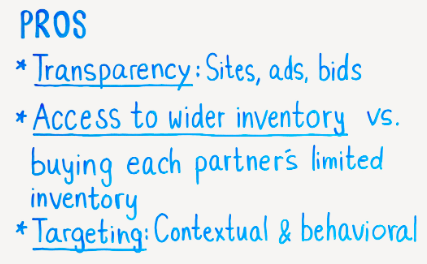
But like with all good things, there are also cons, and in this case, there are high risks. That is especially true for the high eCPI you can reach on your campaigns, as opposed to ad networks where you purchase a flat CPI – with DSPs, you’re buying on a CPM level.
First, in general, buying on the CPM level can generate a much higher cost at the beginning compared to a flat CPI on an ad network, like for other channels. Second, there is a lack of control at the beginning. All those pros we described above come into effect only after you get past the learning curve.
Third, we must remember that we are up against not only our friends the game developers or the performance marketers, but we are also against, in this case, brands that buy on a massive scale depending on their campaigns and periods in the year that affect the CPM. That being true, the competition is quite fierce.
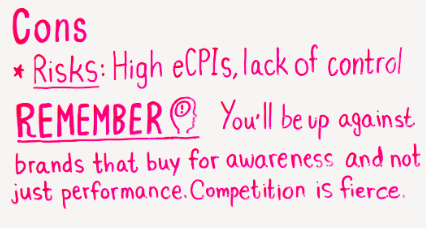
How do I best make programmatic work for me?
So, how do we do it – how do we hedge those risks I just discussed?
First, at the beginning, we need to find ourselves the best solution – but is it a managed one or a self-managed one? There are a couple of DSPs in the market that you need to look into. If you have a dedicated, experienced campaign manager, you should go for a self-managed solution. If you believe in the tech your partner is offering you, you should go with the managed solution, as it offers a user-friendly technological solution, outer bidding, and, of course, less time spent on campaign building.
Second, if you do build those campaigns, you should always do it based on segmentations. You can use those targeting options I discussed and, of course, you can be much smarter when you’re buying because you’re not running on inventory. Now, when you are buying, it’s based on targeting specific users and on specific sites that you can choose from. This is a must – to whitelist those campaigns that you need to work for you.
The third point is to master analytics. Buying is programmatic, but the ROI and understanding the value is on you. If you don’t see the value at the beginning, you have to understand why and you have to understand where the value should come from. This only happens if you understand the platform, the numbers, and where you can reach that value that you’re seeking earlier on.
Fourth, if you seek installs, one big tip I can share with you is to skip the mobile web inventory. At the moment, we see that less conversions are coming from this channel – if anything, it only helps the eCPI to grow, meaning the CPMs will also be higher.
Fifth, for the long run, set your KPIs accordingly. The eCPI will be high at the beginning and ROI will be low, but only at the beginning. As a first step, you should try to learn – study the market and then you will reach your KPIs. If it’s in a month’s time, three months’ time, six months’ time, this is the timeframe you should look to with this kind of media bank.
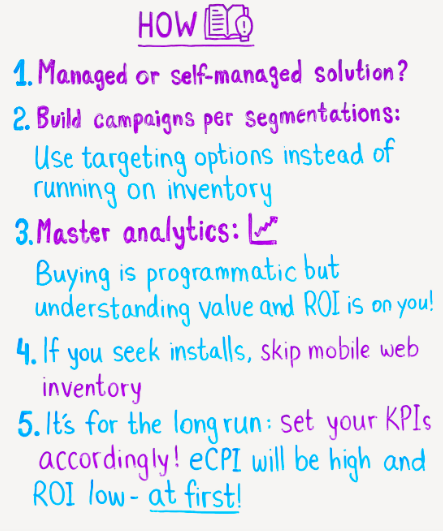
Are there more tips you can share?
Here are some more tips that I can share with you. So first of all, talk with your SSPs, not just your DSPs. You’ll know where your inventory is going because, as we mentioned, there is full transparency. You should talk with them to understand what’s behind the DSP wall – let’s call it like this. The data capability starts with them. They see the inventory, they know what they can guarantee you, and they work with those DSPs.
For example, the SSP can build packages of targeting segmentations for you and then you can target those users with your DSP. There are ad capabilities that maybe your DSP partner isn’t aware of and is not utilizing, but that, at the same time, your rivals are using. You can take that insight and share with your DSP to make sure that you’re running on all capabilities.
Second, explore direct deals with other developers. Once you find quality – or pockets of quality as we call it – try to reach those guys and discuss with them how to make a direct deal that will be beneficial for you both. This is something that we do and we see great value in it, for our side and for the publisher side, whose direct app we are using. You can do it as well through the DSP and SSP.
Third, use market intelligence tools. If you have the capability to use a marketing intelligence tool and understand where your competitors are running, then know that they have already done some of the work for you. You can see their targeting, you can see where they are buying, and from there, you can try to narrow that risk that we discussed in order to make your value higher and your beginning even better.
That last one probably isn’t for everyone, but those tips overall really helped us to understand the market and understand the channel.
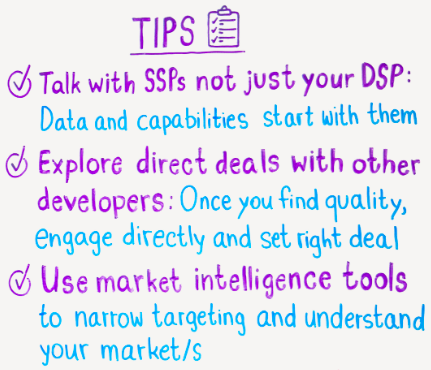
Bottom line
The bottom line, for us: the higher the risk, the higher the reward. Basically, if you can understand this market, understand the capabilities that your partners are capable of, you can reach the ROI you set.
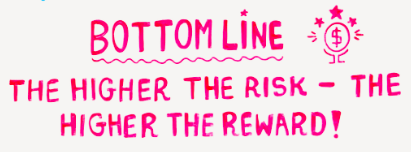
That’s it for today. If you’d like to leave a comment, please do it below. If you’d like more MAMA Boards, you can click on the link here. Thanks a lot for watching and see you next time.



